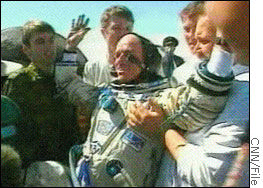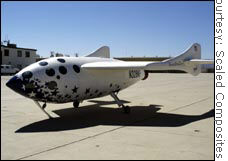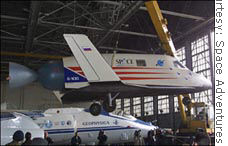NEW YORK (CNN/Money) -
Many people want to go to space, but unless it's your job, odds are you can't afford the ticket. Some outfits think they can change that equation.
So far, only two have shelled out the money. American Dennis Tito and South African Mark Shuttleworth each paid $20 million for flights to the International Space Station, arranged through the Russian space program. Plans for two more $20 million trips were announced in December. Some in the field already doubt that private spaceflights will ever be commercially viable for anyone but the very rich.
 |
|
| Dennis Tito's 2001 flight for $20 million was the first paid trip to outer space. |
"The challenge of putting people into space is very difficult. Only three nations have ever done it," said Mike Mott, Boeing's vice president of space systems. "If we thought there was a real market out there, we'd go after it. But a spacecraft would be $17 billion to build. Put 50 seats on spaceship, charge $150,000 a seat -- to make it viable you have to fly 800 flights a year. That's a giggle factor."
Upstarts see a cheaper way to space
But the companies making pushes for private manned spaceflight say they can do it for a fraction of the cost of NASA and the major NASA contractors such as Boeing and Lockheed Martin, opening space to a much broader range of uses in the relative short term.
 |
|
| Burt Rutan's SpaceShipOne could be the first privately-financed manned spacecraft. |
Innovative aircraft designer Burt Rutan is believed to be close to the first privately financed, non-governmental spaceflight in the coming months. In December, on the 100th anniversary of the first Wright Brother's flight, Rutan's company said the experimental spacecraft SpaceShipOne became the first privately financed vehicle to break the speed of sound during a test flight in earth's atmosphere.
While the plane-launched SpaceShipOne may itself never carry paying customers, it could be the first step toward paid sub-orbital flights. Rutan is competing with 26 other teams from seven nations for the $10 million X Prize, to be awarded to the first group to fly a privately financed three-person spacecraft twice in two weeks.
"Our goal is to demonstrate that non-government manned spaceflight operations are not only feasible but can be done at very low costs," said a statement from Rutan, who built the first airplane to circumnavigate the world without landing or refueling.

| |
|
Click here for CNN.com's space and science coverage
|
|
Jim Benson, CEO of SpaceDev (SPDV: Research, Estimates), one of Rutan's subcontractors, says he believes start-up firms such as his and Rutan's Scaled Composites are in a far better position to offer affordable trips into space than NASA or the major NASA contractors.
"When I got into the satellite business, I was told there was no way to launch a microsatellite for less than $20 million and that it would probably be $40 million," he said. He said his company's first satellite would have cost NASA less than $5 million if not for extra oversight that was required after the agency lost a couple of other probes. The final price was $7.5 million. He said a sub-orbital manned spacecraft could be built for less than $5 million if it didn't have too many regulatory requirements to meet.
"The big guys either don't see or don't believe that lower-cost technology can do the job, or it scares them and they try to block it," said Benson. "SpaceDev and others are like Apple Computers coming into the world of big mainframe computers. Most of the companies they challenged -- the Burroughs, Univacs, Sperrys -- they're all gone."
Tito looking to invest
Tito, who is CEO of the investment management firm Wilshire Associates, says he's ready to invest at least $10 million to develop a sub-orbital space tourism offering, even though the flight would be in outer space for only about 15 minutes. He said he believes it could be brought to reality for less than $100 million, or less than the cost of a single Boeing 767.
 |
|
| Space Adventures, which put two tourists into space, is collecting deposits for those who want a 15-minute space flight for $98,000, perhaps in this Russian-built spacecraft under development. |
"There are very few people who could spend the money I spent," said Tito. "But if individuals could experience the flight similar to [first U.S. Astronaut] Alan Shepard for under $100,000, there are a lot of people with a love of space waiting to have that experience." And Tito said he believes there are enough interested "angel investors" such as himself willing to take the chance on developing the industry due to their personal interest in space.
| 
| |

| 
| 
|

|
 First space tourist Dennis Tito talks about the idea of commercial space travel and his time aboard the International Space Station. First space tourist Dennis Tito talks about the idea of commercial space travel and his time aboard the International Space Station.
|
 Play video
Play video
(Real or Windows Media)
|
| 
|

|
|
It was Space Adventures, the company that arranged for Tito's and Shuttleworth's flights, that announced Wednesday it had arranged for two more passengers on a Russian Soyuz spacecraft to go to the International Space Station. It will be the first Soyuz launch specifically for the purpose of space tourism, rather than taking a tourist along on another mission.
But Space Adventures has also taken deposits from 100 people for a 15-minute sub-orbital flight at a cost of $98,000 that it hopes to be able to offer by 2007. It is working with a Russian firm, Cosmopolis XXI Aerospace Systems, on its own three-passenger sub-orbital spacecraft.
In the 42 years after the first Wright brother's flight, there were 31 million passengers on commercial domestic flights in the United States, and the boon in post-World War II air travel was just about to begin. The fact that there have only been two paying commercial passengers in space is partly due to the greater technical difficulties of space flight. But Space Adventures CEO Eric Anderson says NASA is partly to blame for the slow development of manned commercial flights into space.
| Related stories
|

|
|
|
|
"During Apollo, there was no incentive to make things less expensive, only to win and beat the Soviet Union," Anderson said. "That same philosophy that allowed us to win the space race slowed us down after the space race. The same people were in charge, the same philosophy was there. There was no incentive to make it economical or commercially feasible."
NASA did not have a official available to comment directly on Anderson's critique, but issued a statement saying it did expect commercial manned space flights to take place.
"As a pathfinder, NASA expects others to follow," said a statement from William Readdy, associate administrator of its office of space flight.
"The agency's role in the development of the communications satellite in the late 50s and early 60s led to today's burgeoning telecommunications industry. It would come as no surprise if entrepreneurs and innovators from the private sector successfully build on what we've pioneered in human space exploration. We wish them well."
Space stations, manufacturing and more
Among the grandest plans for private spaceflight is Space Island Group, which is looking to raise $5 billion to develop a shuttlelike vehicle using the space shuttle's fuel tank to go into orbit, then turning that empty tank into a space station in low earth orbit.
 |
|
| Space Island Group believes it can put privately financed space stations in orbit by 2008, using discarded fuel tanks. |
Space Island CEO Gene Meyers believes his company will find the interest in businesses that want to explore the possibilities of zero-gravity manufacturing, as well as some space tourism. He says that naming rights for the space stations, plus leases for laboratory space, will provide the company with the capital it needs to build the first three spacecraft and space station modules.
"We still think we can hit the 2008 target date," he said. "We think the real money comes off of manufacturing. In addition to the charges for taking them into space and laboratory space, we'll require a 5 to 10 percent royalty on all products made up there. We'll be able to ride coattails of that success."
Meyers said he's set to make a pitch to the pharmaceutical industry at a conference this spring and that other major diversified manufacturers are also expressing interest.
Click here for a look at aerospace stocks
"We expect to walk out of conference with half dozen firm letters for leases and perhaps one or two for naming rights. We should be able to start cashing checks in April."

|

